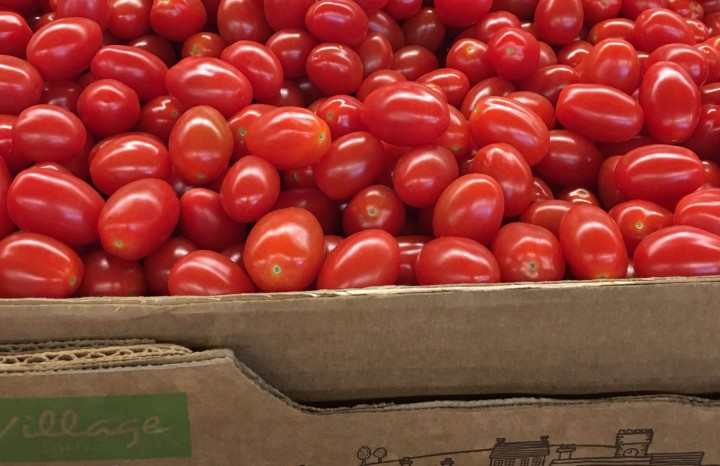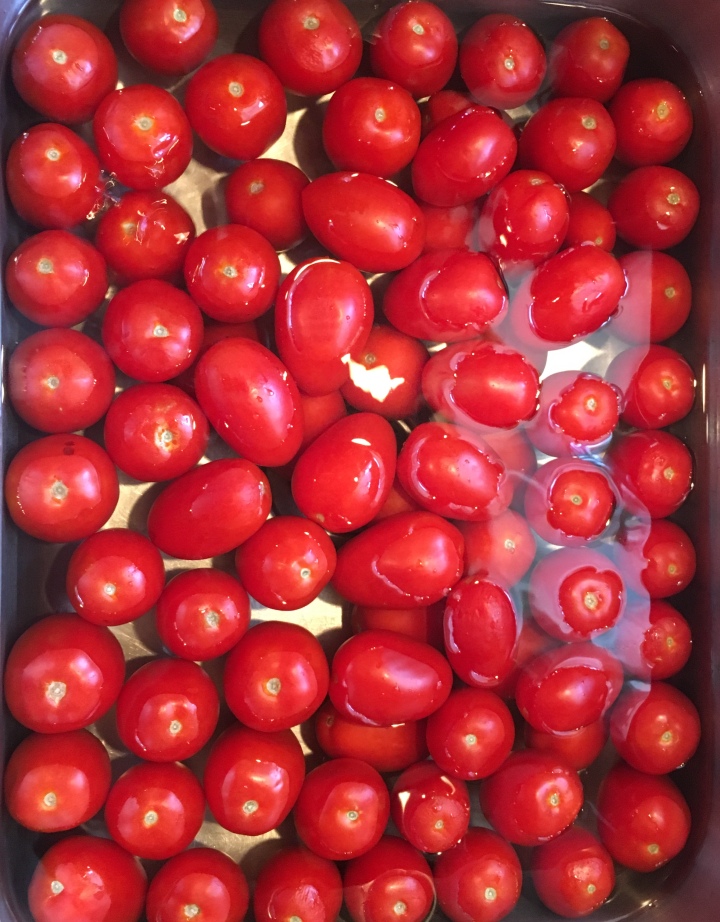In the last few weeks, we’ve had in our kitchen 40 pounds of roasted Hatch chiles and 11 pounds of Mini San Marzano tomatoes. I’ve found that I can eat tomatoes and roasted chiles on just about anything. Our freezer is filled with frozen long green chiles.
We’ve since returned to Village Farms Greenhouse for more tomatoes, and until a few days ago, a crate of big, beautiful Roma tomatoes sat on our breakfast table, awaiting its fate. The market price for the Romas, when we bought them, was $13 for 20 pounds. How can tomato-lovers like us pass up that deal?

With this batch of tomatoes, my husband dragged me into uncharted kitchen territory… canning. He’s canned in the past, but I didn’t have any real experience with it.
Canning food in glass jars was first invented in 1809 by a French inventor named Nicholas Apert. His method sterilized, pasteurized and preserved food for army and navy use. People have been canning food ever since.
Canning takes cooking and food storage to another level. By putting the food items in the glass canning jars and exposing it to high heat, food contaminants are destroyed and air is removed from the jars. A vacuum seal forms with the lids and the chance for contamination is eliminated. There are two different ways to can food at home, water bath canning and pressure canning.
Water bath canning is best for fruits and fruit juices, jams, jellies, salsa, tomatoes, pickles, relishes, chutneys, sauces, pie fillings, vinegars, condiments and anything that is highly acidic. This process uses a lower temperature in the pressure cooker, and with the proper amount of time and temperature, destroys mold yeast and enzymes that would otherwise cause the food to spoil.
Pressure canning is ideal for low acid foods like meats, poultry, salsa, vegetables, chili and seafood. It uses high temperature (240 degrees F) to destroy food borne bacteria to prevent spoilage.
My husband located his old stovetop pressure cooker (because my trusty InstantPot wouldn’t do for this job), and we got to work.

Twenty-pounds of tomatoes, minus the two dozen or so tomatoes that we gifted to neighbors and ate, left us with about 85 beautiful red Romas. We washed them, scored the tops, blanched them by putting them, about a dozen at a time, into boiling water for about two minutes, then put them in an ice bath in the sink for a few minutes for the skin to easily peel off. Next, we squeezed the seeds out of them. I’m sure I’ll be finding tomato seeds all over for a while.

Mr. Johns manned the pressure cooker and canning station. He filled each quart jar with the cleaned tomatoes, a little pink salt, fresh squeezed lemon juice, and a few leaves of fresh basil.
With everything properly assembled, within the hour, we were rewarded with seven quarts of preserved tomatoes, ready to be used just as store-bought cans of tomatoes are… for a fraction of the price and of the best quality. We listened for the telltale “pop” of each lid, the sure sign that the jar is vaccuum-sealed. I think this canning thing might become a very good habit.

Preserved and cooked tomatoes… no air inside there means no contamination possible.
Canning Tomatoes
- (Whole, halved or quartered – this is the technique we used)
- 2-1/2 to 3-1/2 lb. ripe tomatoes (about 8-11 medium) per quart jar
- Water
- ¼ – ½ teaspoon Ball citric acid (found with the canning jars at the grocery store) or lemon juice
- Salt, optional
- Preserving jars with lids and bands (we used Ball)
- Prepare boiling water canner. Heat jars in simmering water until ready for use, but do not boil. Wash lids in warm soapy water and set them aside.
- Wash tomatoes. Dip in boiling water for 30 to 60 seconds (we went almost 2 minutes). Immediately dip in cold water. Slip off skins. Trim away any green areas and cut out core. Leave tomatoes whole or cut into halves or quarters.
- Add ½ teaspoon Citric Acid or 2 tablespoons of lemon juice to each quart jar (half for pint jars).
- Pack tomatoes into hot jars, leaving 1-inch headspace. Ladle hot water over tomatoes, leaving 1-inch headspace (water will fill in the gaps). Add 1 teaspoon salt to each quart jar, ½ teaspoon to pint jar, if desired.
- Remove air bubbles. Wipe rim. Center hot lid on jar. Apply band and adjust until fit is fingertip tight.
- Process filled jars in a boiling water canner for 40 minutes for pints, 45 for quarts, adjusting for altitude. Remove jars and cool. Check lids for seal after 24 hours.Lids should not flex up and down when center is pressed.
Printed with permission of the Alpine Avalanche.







I was given some tomatoes and I canned half pints of juice for cooking. I am retired and the jelly jar size was just what I needed. I ended up with a dozen jars. I used a pressure cooker to process them. I have a Carey that came with a 10lb and 15lb weight. It is perfect for small batch canning.
LikeLiked by 1 person
The juice works great as a water replacement in so many things! I’m still learning… our big jars have some empty space at the top that he says next time, he will fill fuller. I’m thinking I prefer a little smaller than than a quart, but we haven’t used them yet so time will tell… 🙂
LikeLiked by 1 person
Ball has a plastic tool that you can use to slide around the side of the inside of the jar to release the air that is trapped while filling the jar. Growing up we used a butter knife and you will see the air bubbles come up to the top, Then you add more to the jar. You fill tomatoes an inch from the top of the rim. If you haven’t watched any of the you tube videos on canning tomatoes, you should because they demonstrate this. I do, just to get me organized and refresh my memory. I am sure the jars are fine even if they are not filled all the way up.
LikeLiked by 1 person